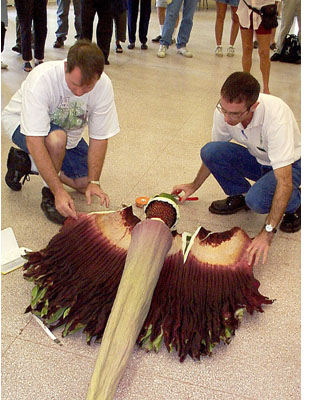
Harvesting Amorphophallus titanum at Fairchild
Alice the Amorphophallus donates her body to science... The six foot one and one-half inch Amorphophallus titanum (Titan Arum) specimen was harvested for scientific study on Thursday, September 9. The public was invited to observe DNA sampling and vouchering as the plant was converted to a dried herbarium (museum) specimen. The decision was made to preserve it at its peak since it withers and wilts quickly after blooming. While it was still a very attractive specimen, the spathe that we had been hoping was going to finish opening, had taken on a slightly desiccated look. There was no expectation that it would open. We had decided that to get the most usable vouchered herbarium specimen we would harvest the inflorescence before it deteriorated.
Vouchering is a scientific process of collecting and preparing the live plant as a dried and pressed specimen to be archived in a herbarium. The Fairchild Herbarium houses more than 165,000 specimens used for scientific study. Fairchild's virtual herbarium is the world's first herbarium on the internet.
DNA testing allows scientists to look at the actual code that differentiates that code from different and similar species. The code is not influenced by growing location or other factors. DNA studies of tropical plants are in its infancy. The scientific records of this rare species, not easily accessible to most botanists, will enable future study of its morphology. Preserving the DNA makes the information available even when the plant is not growing or in bloom. Fairchild Tropical Botanic Garden is in the process of creating a DNA bank of plants growing in Fairchild.
The drawing for the only young Amorphophallus titanum plant in Fairchild was held after the bloom was prepared for inclusion in the herbarium. A young member of the audience drew the card and Valrae Spatz , a painter and Coconut Grove, Florida resident, won the young plant now in the leaf stage of growth. Craig Allen, Fairchild's Conservatory Manager and Amorphophallus horticulturist, will assist her in determining the perfect growing location for her new beauty.
Why the name "Alice"? It was a Fairchild staff member who fondly named this year's bloom "Alice the Amorphophallus."
Preparing the specimen for herbarium archiving
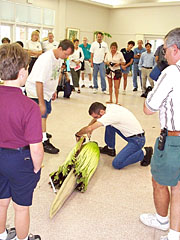 |
| Initial opening cut |
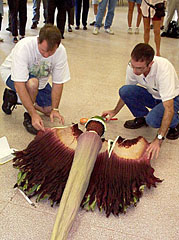 |
| Spathe is laid flat |
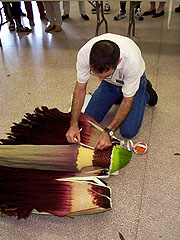 |
| Measurements are taken |
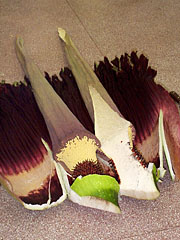 |
| Spadix cut vertically |
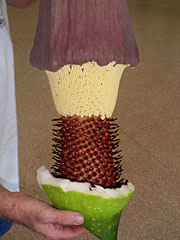 |
| Pollen and flowers |
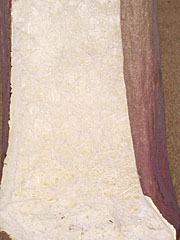 |
| Spadix interior |
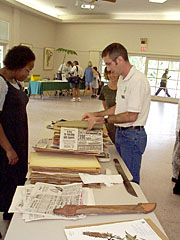 |
| Plant press being layered |
 |
| Plant press |
Farewell to Alice
by Craig M. Allen, Conservatory Manager 1999
The farewell ceremony for Alice the Amorphophallus was well attended. A large number of Fairchild Garden staff, Garden members, the Coconut Grove Garden Club, Georgia Tasker reporting for the Miami Herald, several television stations, and some of Alice's visiting public were all gathered to record and watch Dr. Scott Zona harvest the 6 foot 1 1/2 inch inflorescence. I mention the height because when we cut it down we found that it had grown an inch after we thought it had quit and had stopped measuring it.
I held the plant as the machete wielding Dr. Zona sliced into the stalk below the spathe. Honestly it hurt.
It surprised me at how light that huge thing was. It is a strange sensation to be carrying a flower that is taller than you are. We carefully laid it down on the floor to further slice and dice the huge bloom into manageable pieces that would fit into a herbarium press.
Before any cutting, Dr. Zona measured all the parts of the enormous bloom, recording each in his journal. He fully explained, to a spell bound audience, the process, importance and future of the plant material we were taking.
As Dr. Zona started cutting the spathe, the crowd quieted in anticipation. Then when the ruffled spathe was removed from around the spadix the vivid deep red was exposed to lots of ooo's and aaah's. The flower covered areas were really beautiful, but what really surprised me was the rich lavender color on the lower part of the hollow spadix area. The spadix looked for all the world like a giant 6 foot pod of okra as it lay there, naked. I had seen photos of the inside of a titanum but this was right in front of me.
A vertical slice to the spadix, and it fell into two pieces. I noticed that Dr. Zona and I both checked our finger for any signs of the infamous odor that Amorphophallus titanum is known for. There was no trace. Looking inside the hollow part of the spadix was strange. The cavity is filled with slender white threads, looking much like what one of those woven nylon kitchen scrubbing pads would look like if it was pure white and had exploded. There was no obvious organ for producing the oil responsible for the titan's stench. The plant material that filled the lower solid part of the spadix had the look and feel of wet styrofoam.
After being admired and photographed by all present, the spathe and spadix were divided into sections that would fit on the herbarium specimen sheets. Two complete sets were prepared and after bundling, the first bloom of Alice the Amorphophallus was off to the Center for Tropical Plant Conservation dryer.
After the harvesting in Garden House, the drawing was held for the winner of a young Amorphophallus titanum plant. We asked a young member of our audience, Armond Boero, to put his hand in the large vase full of tickets and draw the winning number. The young son of a Fairchild member, he has been so fascinated watching this bloom grow here at Fairchild and on the internet that his mother had him excused from his classes at Killian Oaks Academy to witness the harvesting in person. The name on the ticket Armond drew…? Mrs. V. Spatz of Coconut Grove, Florida. She is a Fairchild volunteer, and is about to start working on our rainforest exhibit. She will adopt her new plant tomorrow. We have agreed that I will visit her 1/2 acre bay front home and garden to select a suitable location to raise her Titan.
…It's over. After three long… and all too short weeks there is no beautiful inflorescence waiting for me in Garden House. Many of the staff I work with thought I would be upset watching this operation. I thought so too, but after that first slice of the machete my curiosity took over and I was as fascinated as everyone else. As I took down the display later that afternoon, I could almost hear Alice the Amorphophallus (the tuber) thanking me for taking the pot she lives in back to that nice wet conservatory she has called home for the last four years.
DHTML JavaScript Menu By Milonic.com
Copyright © 2007 Virtual Herbarium - All rights reserved
11935 Old Cutler Road, Coral Gables, FL 33156-4299 USA
Phone: 305-667-1651 • Fax 305-665-8032
